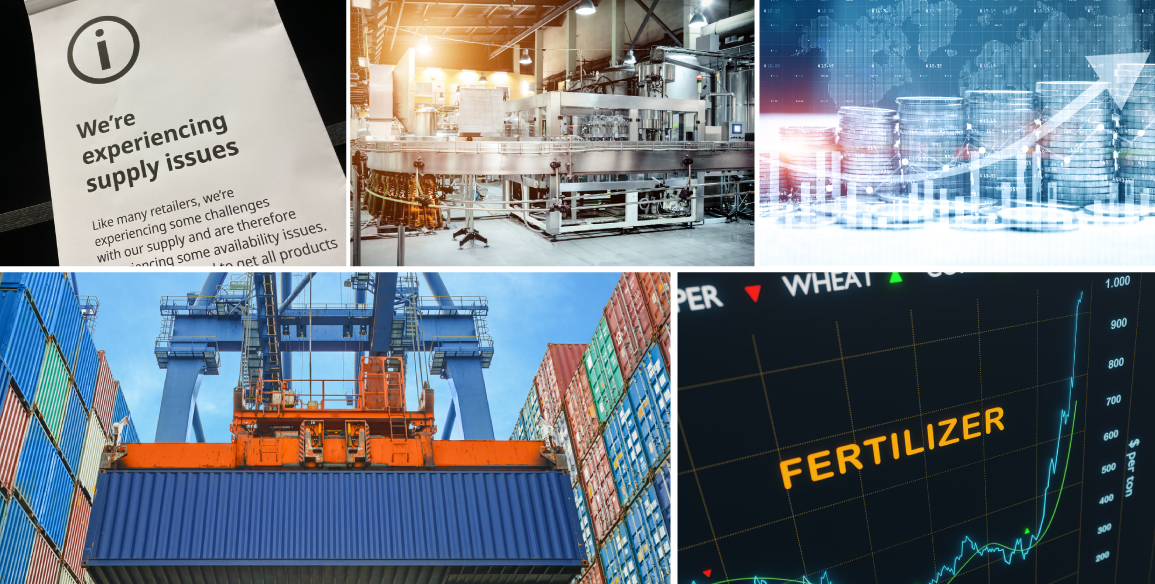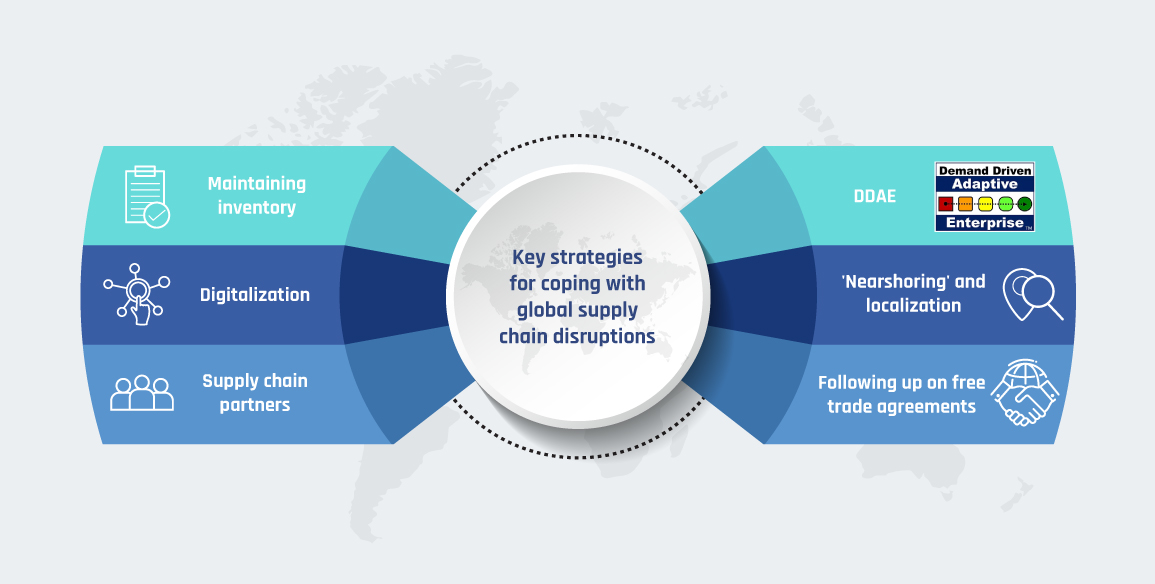
Future Supply Chain: 5 Industries that Will be Affected the Most
November 18, 2022
DDAE in Real Estate Supply Chain
December 16, 2022You may have been keeping a close eye on the news lately and noticed that there has been an increasing number of global supply chain disruptions. This is likely due to various factors, including the pandemic, global geopolitical factors, and climate change.
The COVID-19 pandemic has made businesses aware of the vulnerability of global supply networks. Global shortages and inflation have resulted from increased demand, trade restrictions, manufacturing closures, rising freight charges, and reliance on ‘just-in-time’ inventory management.
Supply chain disruption has grown increasingly common, progressing from an industrial issue to a danger to economic stability. Due to scarcity and increasing input costs, food, gasoline, and building materials prices have continued to rise. Promoting flexible and robust supply networks to weather the storm will be critical.
Supply chain vulnerabilities globally
Supply chain disruptions result in crucial product shortages, price escalation, industrial closures, unloaded shipping containers, and negative repercussions on a country’s economic well-being. They also influence a wide range of products, from high-priced items like vehicles and technology to basics like food, medication, oil, and gas, all of which affect the cost of living.
The large and compounding impact of supply chain bottlenecks and on pricing, particularly for producers and manufacturers that import supplies such as fertilizer and building materials, have major economic repercussions. Asia Pacific economies, many of which rely primarily on imported commodities, are sensitive to the effects of supply chain disruption on output and consumption.

What is DDAE?
The Demand Driven Adaptive Enterprise (DDAE) model is a management framework that enables businesses to recognize changes in the market, adjust to uncertain, complex situations, and create market-driven innovation initiatives.
Key to the process is the idea of elasticity, which allows companies to quickly adapt to changes in the market without sacrificing quality or customer service. By using DDAE, companies can build in redundancies and buffers that help them weather any disruption.
In today’s global economy, DDAE has become more important than ever.
With geopolitical factors and climate change disrupting traditional supply chains, companies must be prepared for anything. That’s where DDAE comes in.
What are the key strategies for coping with global supply chain disruptions?
It may cost businesses more to promote supply chain resilience in the short term. Still, in the long run, a more robust supply chain will lessen the impact of external shocks on the bottom line. Most organizations affected by pandemic supply chain shocks have stated that they want to make their supply networks more flexible, agile, and resilient. Some of their strategies are outlined below.
Maintaining inventory
This entails keeping ‘additional’ stock or parts on hand if the supply source is disrupted. While the expense of additional inventory may be challenging to explain, recent experience has demonstrated the cost to the business of a delay in procuring such inventory.
For example: the worldwide microprocessor scarcity has put pressure on the automotive and electrical industries, leaving thousands of laptop orders unfulfilled. Alternatively, corporations may store inventory, carefully choosing when and at what price to release it.
Digitalization
Businesses might utilize AI to detect hazards, potential shocks, or underperformance in the supply chain before they become a problem. Access to sales data and forecasts may enable suppliers to identify the amount of stock required more appropriately.
Technology can also be used to map a company’s supply chain more precisely, not just to the first tier (the company’s direct supplier) but also to the second tier (the company’s supplier’s supplier) and beyond. A detailed supply chain map can help organizations discover riskier places along the network, allowing them to manage that risk and make their chain more trustworthy.
Supply chain partners
Another key strategy is to use key supply chain partners. Companies can create a more resilient supply chain by working with carefully selected partners. These partners should be able to adapt quickly to market changes and have the necessary resources and capacity to help maintain a consistent supply of goods.

DDAE
DDAE is a business model that allows companies to adapt to market demand changes quickly. It does this using real-time data analytics to make near-instantaneous changes to production schedules and supply chains. This will enable companies to respond quickly to changes in demand and helps to ensure that they have the right products in the right places at the right time.
Nearshoring and localization
Some businesses use more local materials to reduce their reliance on foreign trade and supply networks.
Nearshoring is the practice of depending on suppliers geographically closer to manufacturing facilities to save transportation costs and time, increase product quality, and lower risk. Because some products involve resources that cannot be found locally, nearshoring is sometimes a better or more feasible option for localization.
The US Congress passed the CHIPS Act in July 2022 to promote American semiconductor production, design, and research and strengthen America’s chip supply networks.
Following up on free trade agreements
Supply chain experts should stay up to date on free trade agreements and their implications for their specific supply networks. Recent efforts in the APAC region to encourage free trade include the Regional Comprehensive Economic Partnership Agreement, the Comprehensive and Progressive Agreement for Trans-Pacific Partnership, and the Pacific Agreement on Closer Economic Relations Plus. Such agreements can impact competitive plant sites, distribution operations, sales, and input sourcing.
DDAE as a key strategy for coping with global supply chain disruptions
Disruptions to the global supply chain can happen for various reasons, including pandemics, global geopolitical factors, and climate change. When these disruptions occur, companies need to have a plan to help them cope.
One key strategy is to use Demand-Driven Adaptive Enterprise (DDAE). DDAE is a methodology that helps organizations match supply with demand in real-time. It uses data analysis to create a more accurate picture of customer demand. This allows companies to plan and respond to disruptions and helps them to get products to customers more quickly.
Using DDAE can help companies to manage their global supply chains better and can help them to get products to customers faster and more efficiently.
The benefits of using DDAE to cope with global supply chain disruptions
There are many benefits to using DDAE to cope with global supply chain disruptions. DDAE can help you to:
- Understand the root cause of disruptions and how they affect your business.
- Identify potential areas of disruption and develop contingency plans.
- Monitor the impact of disruptions on your business and make necessary adjustments to your plans.
- Communicate with your suppliers and customers to keep them updated on the situation.
- Keep your business operations running smoothly during periods of disruption.
How DDAE can help companies cope with global supply chain disruptions
DDAE is a crucial supply chain strategy that can help companies cope with global disruptions. DDAE allows companies to understand the current state of the supply chain, identify risks and opportunities, and adapt their execution plans accordingly.
DDAE constantly monitor the supply chain and identify changes in demand, supply, and other factors. This information is then used to adapt the execution plan in real time, ensuring that the company can respond quickly to changes in the market.
Companies have successfully used DDAE to cope with global disruptions such as the COVID-19 pandemic and Brexit. By using DDAE, companies can quickly adapt their plans to changes in the market and ensure that they can meet customer demand.
The future of global supply chains
What does the future of global supply chains look like? Well, that’s a tricky question to answer. But the coronavirus pandemic has highlighted the need for companies to be more agile and adaptable regarding their supply chains.
We’ve also seen a shift in global supply and demand and a rise in protectionism and nationalism. So, it’s clear that the landscape of global supply chains is changing.
To stay ahead of the curve, companies must continue investing in DDAE and other critical supply chain strategies. They’ll also need to be more transparent and clearly understand their entire supply chain.
The only way to ensure that your company is prepared for whatever may come is to continue to invest in your supply chain, DDAE, and other key strategies.

FAQs on DDAE and global supply chain disruptions
What is DDAE?
The Demand Driven Adaptive Enterprise (DDAE) is a management approach that allows you to incorporate adaptiveness and agility into your business. It guarantees that all areas of your organization collaborate to support the seamless flow of information and materials — and that everyone has timely access to the data required to increase resilience and agility.
What are some of the benefits of using DDAE?
Some of the benefits of using DDAE include being able to respond to changes in demand more quickly, being able to allocate resources more efficiently, and being able to reduce costs.
How can DDAE help companies cope with global supply chain disruptions?
DDAE can help companies cope with global supply chain disruptions by assisting them to be more agile and adaptable. By being more agile, companies can quickly change their supply chains to meet changing demands. Additionally, by being more efficient in resource allocation, companies can reduce costs associated with disruptions.
Conclusion
The bottom line is that DDAE and other key supply chain strategies can help companies cope with global supply chain disruptions. While the pandemic has been a significant driver of these disruptions, other factors, such as climate change and geopolitical tensions, are also playing a role. By implementing DDAE and other key strategies, companies can improve their resilience and adaptability and better meet the needs of their customers.
Interested in knowing how Patrick Rigoni can step up the game of your supply chain? Contact us today and get a free consultation.
Patrick Rigoni also offers in-depth DDMRP courses; if you are interested to know more about DDMRP for the supply chain for your company, here is the link to the NEW DDMRP Page.




